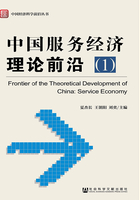
四 简要评论
从整体上看,关于服务业效率的研究一直是困扰经济学家的一个大课题。
第一,服务业效率的测度,绕不开服务业价格的问题 。例如,富克斯研究发现,1929~1965年,服务产出在非农产业中的比重上升了2个百分点。但是,如果以不变价计,服务业的产出比重反而下降了2.4个百分点,其原因是在此期间服务的价格上升了大约14个百分点。又如,鲍莫尔发现,20世纪60年代以来,发达国家的教育、医疗等服务行业的价格以远远超过一般通货膨胀水平的速度增长。因为对服务价格影响的处理方法不同,也导致了对服务业效率或生产率研究结论的差异。
。例如,富克斯研究发现,1929~1965年,服务产出在非农产业中的比重上升了2个百分点。但是,如果以不变价计,服务业的产出比重反而下降了2.4个百分点,其原因是在此期间服务的价格上升了大约14个百分点。又如,鲍莫尔发现,20世纪60年代以来,发达国家的教育、医疗等服务行业的价格以远远超过一般通货膨胀水平的速度增长。因为对服务价格影响的处理方法不同,也导致了对服务业效率或生产率研究结论的差异。
第二,对服务业效率或生产率的研究,不能简单套用关于物质产品生产效率的研究方法。服务业效率或生产率不但涉及服务业本身的技术进步、服务提供者的技能水平,而且也涉及服务的需求、服务接受者的配合等诸多因素,因此,在现有的框架下进行分析,可能会导致结果的偏差。
第三,对服务业投资效率的研究,目前仍处于起步阶段。核心的问题是缺乏一种良好的计量方法对服务业投资效率进行测度。还有一个相关的问题是,服务业投资非常庞杂,既有公共投资,也有私人投资,而且,各个行业之间投资水平差异非常大,这些问题都导致了对服务业投资效率的研究仍处于起步阶段。
第四,服务业效率比制造业更容易受到政府行为的影响。但是,对于政府行为影响服务业效率的机制、作用路径、数量水平等,在研究方面仍不够深入,有待于引进新的观察方法以及分析模式。
总之,虽然服务业在GDP与就业中的地位越来越重要,但是,对其效率的研究仍处于起步阶段,在未来的研究中,仍需要在研究方法、研究模式等各个方面深化,使其在理论与实证方面更加深入。
参考文献
[1] 李勇坚、夏杰长:《制度变革与服务业成长》,中国经济出版社,2009。
[2] 庞明川:《中国的投资效率与经济可持续增长》,中国社会科学出版社,2008。
[3] 〔荷〕腾·拉加、〔德〕罗纳德·谢科特:《服务业的增长——成本激增与持续需求之间的悖论》,李勇坚译,格致出版社,2012。
[4] 夏杰长、李勇坚等:《迎接服务经济时代来临》,经济管理出版社,2010。
[5] 曹跃群、张祖妞、郭春丽:《服务业资本利润率变动趋势及成因》,《产业经济研究》2009年第5期。
[6] 陈建军、陈国亮、黄洁:《新经济地理学视角下的生产性服务业集聚及其影响因素研究——来自中国222个城市的经验证据》,《管理世界》2009年第4期。
[7] 陈金保、何枫、赵晓:《税收激励对中国服务业生产率的作用机制及其实证效果研究》,《北京科技大学学报》(社会科学版)2011年第3期。
[8] 陈艳莹、王二龙:《要素市场扭曲、双重抑制与中国生产性服务业全要素生产率:基于中介效应模型的实证研究》,《南开经济研究》2013年第5期。
[9] 陈志武:《为什么中国出卖的是“硬苦力”》,《新财富》2004年第9期。
[10] 郭东海:《我国生产性服务业产业政策的微观研究》,《东岳论丛》2010年第12期。
[11] 胡东兰:《中国财政支出对居民服务消费影响的理论及实证分析》,中国社会科学院研究生院博士学位论文,2013。
[12] 胡宗彪:《企业异质性、贸易成本与服务业生产率》,武汉理工大学博士学位论文,2013。
[13] 江小涓:《服务业增长:真实含义、多重影响和发展趋势》,《经济研究》2011年第4期。
[14] 李文秀、李勇坚、罗春秀:《中国区域间服务业发展趋同还是集聚—基于省级分行业投资效率面板数据的研究》,《宏观经济研究》2012年第8期。
[15] 李勇坚、夏杰长:《服务业是节约投资的产业吗?——基于总量与ICOR的研究》,《中国社会科学院研究生院学报》2011年第9期。
[16] 刘丹鹭:《进入管制与中国服务业生产率——基于行业面板的实证研究》,《经济学家》2013年第2期。
[17] 刘丹鹭:《我国服务业生产率及其影响因素研究》,南京大学博士学位论文,2012。
[18] 刘培林、宋湛:《服务业和制造业企业法人绩效比较》,《经济研究》2007年第1期。
[19] 汪德华、张再金、白重恩:《政府规模、法治水平与服务业发展》,《经济研究》2007年第6期。
[20] 王劲松、史晋川、李应春:《中国民营经济的产业结构演进——兼论民营经济与国有经济、外资经济的竞争关系》,《管理世界》2005年第10期。
[21] 吴建新:《技术进步、效率变化、资本积累与我国地区服务业发展》,《南方经济》2010年第8期。
[22] 夏杰长、李勇坚:《中国服务业投资的动态效率分析》,《中国社会科学院研究生院学报》2010年第11期。
[23] 岳希明、张曙光:《我国服务业增加值的核算问题》,《经济研究》2002年第12期。
[24] Pertit:《新帕尔格雷夫经济学大辞典》(第四册)。
[25] Armando Calabrese, Service productivity and service quality: A necessary trade- off? , International Journal of Production Economics 2012, (135): 800-812.
[26] Anne-Kathrin Last and Heike Wetzel, Baumol's Cost - Disease, Efficiency, and Productivity in the Performing Arts: An Analysis of German Public Theaters, Journal of Culture Economics, 2011, 35 (3): 185-201.
[27] Brian Chapman,“Baumol's Disease”: The Pandemic That Never Was, Monash University, Australia, 2010.
[28] Baumol, W., Macroeconomic of Unbalanced Growth, American Economic Review,1967, 57: 415-426.
[29] Chiara Criscuolo, Ralf Martin, Henry Overman, John Van Reenen, The Causal Effects of an Industrial Policy, NBER, Working Paper 17842, http://www.nber.org/papers/w17842,2012.
[30] Christian Grönroos, Katri Ojasalo, Service Productivity: Towards a Conceptualization of the Transformation of Inputs into Economic Results in Services, Journal of Business Research, 2004, 57(4): 414-423.
[31] Clark, C., The Conditions of Economic Progress. London: Macmillan,1940.
[32] Fuchs, V., The Service Economy. New York: National Bureau of Economic Research, 1968.
[33] G. Nicoletti and S. Scarpetta, Regulation, Productivity and Growth: OECD Evidence, Economic Policy,2003, 18(36): 9-72.
[34] Griliches, Zvi., Productivity, R&D, and the Data Constraint, American Economic Review, 1994, 84 (1): 1-23.
[35] J. Steven Landefeld, Barbara M. Fraumeni, Measuring the New Economy, http://www.bea.gov/about/pdf/newec.pdf,2000.
[36] Jellaba Faridah et Gallouj Faïz, Beyond Productivity Strategies in Services, Journal of Innovation Economics,2010, 5:89-104.
[37] Jack E. Triplett and Barry P. Bosworth: Productivity in the Services Industries: Trend and Measurement Issues, Brookings Institution, working paper, 2003.
[38] Kuznets, S., Economic Growth of Nations: Total Output and Population Structure, The MIT Press, 1971.
[39] Leveson, I., Services in the U. S. Economy, In Inman(eds.), Managing the Service Economy: Prospects and Problems, Cambridge University Press, 1985.
[40] Martin Neil Baily, Robert J. Gordon and Timothy F. Bresnahan, Competition, Regulation, and Efficiency in Service Industries, Brookings Papers on Economic Activity. Microeconomics,1993, 2: 71-159.
[41] Masayuki Morikawa, Demand Fluctuations and Productivity of Service Industries, Economics Letters, 2012, 117: 256-258.
[42] Marco Da Rin, Thomas F. Hellmann, Manju Puri, A Survey Of Venture Capital Research, Working Paper 17523, http://www.nber.org/papers/w17523,2011
[43] Nicoletti, G., Regulation in Services: OECD Patterns and Economic Implications, OECD Economics Department Working Papers, No. 287, OECD Publishing, 2001.
[44] OECD, Growth in Services Fostering Employment, Productivity and Innovation,Meeting of the OECD Council at Ministerial Level,2005
[45] Robert J. Gordon, Problems in Measurement and Performance of Services Sector Productivity in the United States, NBER WP No.5519, 1996.
[46] Rubalcaba, L. and H. Kox, Business Services in European Economic Growth, Hampshire: Palgrave Macmillan Ltd,1 edition, 2007.
[47] Rubia Verma, Can Total Factor Productivity Explain Value Added Growth in Services? , Journal of Development Economics 99 (2012): 163-177.
[48] Saxonhouse, G., Services in the Japanese Economy, In Inman(eds.), Managing the Service Economy: Prospects and Problems, Cambridge University Press, 1985.
[49] Sridhar, K. S. and V. Sridhar, Telecommunications Infrastructure and Economic Growth: Evidence from Developing Countries. Applied Econometrics and International Development, 2007, 7(2): 37-56.
[50] Stephen Broadberry, Sayantan Ghosal: Technology, Organisation and Productivity Performance in Services: Lessons from Britain and the United States since 1870, Structural Change and Economic Dynamics,2005, 16: 437-466.
[51] Triplett, J. E. and B. P. Bosworth, Productivity in the U. S. Services Sector: New Sources of Economic Growth, Washington D. C. : Brookings Institution, 2003.
[52] Waverman, L., Telecommunications Infrastructure and Economic Development: A Simultaneous Approach, American Economic Review, 2001, 91(4): 909-923.
[53] Wolff, Productivity and American Leadership: The Long View, The MIT Press, 1991.